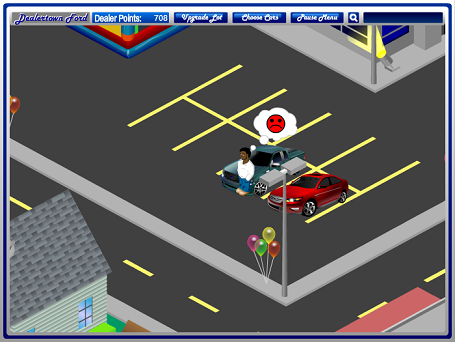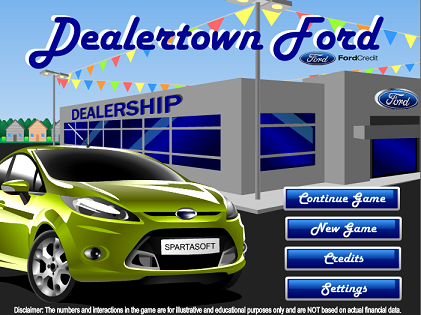Introduction
Dealertown Ford is a simulation game created for the Ford Motor Company subsidiary, Ford Credit. It was designed to teach cutomers about vehicle financing by placing them in the shoes of the owner and primary sales representative of a Ford dealership.
Below is a detailed analysis of this game roughly following Brian Winn's1 Design/Play/Experience framework, including:
Learning
Dealertown Ford is intended to teach the intricacies of both running a car dealership and personal financial literacy, as well as promote the Ford brand. In particular, players learn the importance of saving money and having good credit. Specific goals include:
- Defining sales terms like "APR" and "Down payment"
- Differentiating between high and low risk credit scores
- Encouraging practices like saving money and paying off credit
- Showing the basic process behind Ford's credit approval system
- Raising awareness of new Ford models
Storytelling
In this game, you are cast as the owner and main sales representative of a Ford dealership in Dealertown, USA. Upon arrival at your new dealership, you are greeted by Terri, your Ford representative, who helps you get aquainted with the controls and interface before starting you out on your first sale. Here, she introduces you to Charlie, your financial officer, who helps you throughout the game by giving you feedback on each sale or credit rejection.
 Terri introduces the player to Charlie.
Terri introduces the player to Charlie.
Terri doesn't stay much past this first customer interaction, but Charlie is an ever-present coach, reminding you what to look for in each customer and detailing the results of each customer interaction. This feedback is a vital tool used to shape the player's progress. By receiving praise for a job well done and constructive criticism on mistakes, the player quickly learns the ins and outs of the sales window, and the lessons it has to offer.
Gameplay
The player spends most of their time interacting with customers, reviewing each one's financial details and creating a payment plan that works for the customer, if such a plan exists. Using a customer's current savings, credit history, and monthly budget, the player must determine the appropriate down payment, APR interest rate, and payment term options that best fit the customer. When a player creates a deal that benefits the customer and the dealership, they earn points. The better the deal, the more points the player earns. If the deal is bad enough, the player does not gain any points at all.
The rest of the gameplay is spent managing the dealership. The player must choose which models to display on the lot and replace cars that have already been sold. Players can also choose to spend points on upgrades for their dealership, each with various effects. For example, a billboard or a giant inflatable ape will increase the maximum number of points gained from a successful sale, while a banner or a welcome sign will increase the number of visitors to the lot. Trash blown into the lot can be picked up for points, and certain upgrades, like potted plants, can also be interacted with.
 An enraged customer gets ready to leave the lot.
An enraged customer gets ready to leave the lot.
There does not appear to be an ultimate goal for players to reach. Even after every upgrade has been bought, customers will continue to arrive at the dealership until the player decides to quit. Likewise, there is no way to fail. No matter how many customers enter a completely empty lot or walk away totally fleeced, more will come. Though not an accurate portrayal of business at a car dealership, it allows people to play for as long as their interest holds out, and the "no fail" method of play may appeal to a more casual demographic, the likely target audience.
User Experience
All interactivity is achieved through the mouse, from menu selections to parking lot management. During gameplay, the menus take up little real estate, leaving more room for the visuals. The car selection and upgrade menus are somewhat cumbersome, though, as the scroll bars move slowly with a mouse's scroll wheel. However, the upgrade descriptions are succinct, and the product endorsements that display with the cars are small and out of the way enough to be ignored. This last point may not have been ideal for the commercial intent of the game, however.
The user interface, though well laid out, is a bit ugly. It follows the distinctive blue and white motif of the official Ford logo, and even uses the same font for some buttons. Though the logo is appealing, applied to UI design, it is almost reminiscent of the early days of web pages, when simple colors and "exotic" fonts were the norm.
Technology
Dealertown Ford is a Flash application, designed to be played on most major browsers, an excellent choice since it was to be hosted on Ford Credit's website. The graphics aren't stellar, but the cartoony feel is somewhat endearing. The real photos of the various car models felt out of place against the unrealistic background.
Assessment
I was unable to find any official assessments of Dealertown Ford. A pre- and post-test could effectively determine if players learn any of the financial lessons, but not if they harbor any positive reactions to Ford's models and brand. The latter could be determined by polling customers at actual Ford dealerships, asking if they played Dealertown Ford and if their play session influenced their decision to shop at Ford.
 Dealertown Ford's title screen.
Dealertown Ford's title screen.
Conclusion
Dealertown Ford is a good mechanism for teaching financial literacy and responsibility, particularly in regards to the car market. It is perhaps even an effective brand marketing tool. The play is solid, if repetitive, and stays at a fairly constant pace, letting players interact as long as they like without forcing them to speed up or slow down.
The only major improvement I could suggest would be tweaks to the menus; the ugly color scheme and the wonky scroll windows make them difficult to navigate. The menus are the main source of interaction with the game, so it's vitally important that they are as usable as possible. Adding additional feedback during the customer interaction, such as highlighting the changes on the Deal Worksheet after each button press, could also aid in player comprehension.